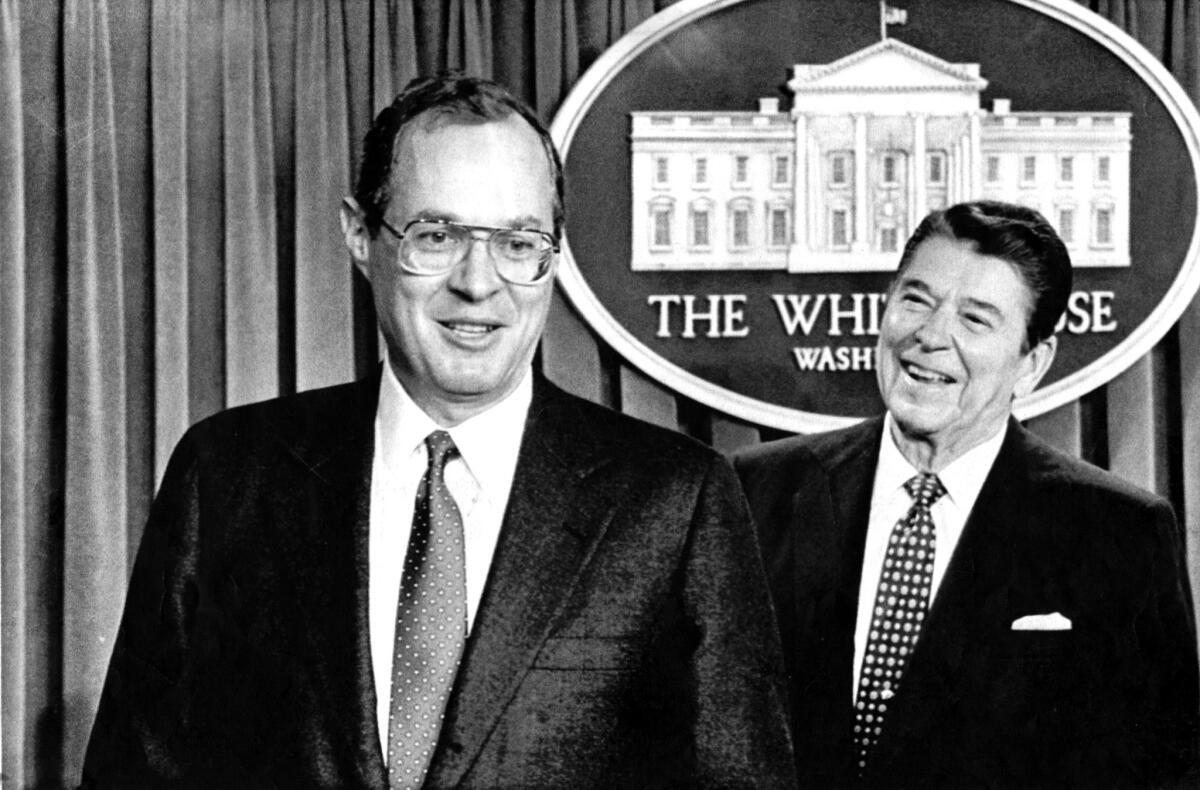Back Story: In Supreme Court battle, does ‘advise and consent’ still work?

President Reagan introduces Anthony M. Kennedy, his Supreme Court nominee, in November 1987.
- Share via
Reporting from Washington — The last great clash between the president and the Senate over a vacant Supreme Court seat ended with a private meeting at the White House between Ronald Reagan and Sen. Joe Biden, then the chairman of the Senate Judiciary Committee.
Earlier that year, 1987, the Senate had voted down Judge Robert Bork, Reagan’s first choice to fill the seat of Justice Lewis Powell, the court’s swing vote in the 1980s. A second nominee, Judge Douglas Ginsburg, had withdrawn amid controversy about his smoking marijuana while a young faculty member at Harvard.
The president, heading into his final year in office, wanted to know who could be confirmed in a Senate controlled by Democrats. One name on his list was Anthony M. Kennedy, a judge from Sacramento on the 9th Circuit Court of Appeals.
“Based on what I know, he’s a mainstream conservative,” Biden said. “He would probably pass.”
“So that means you’re for him?” the president said.
As Vice President Biden now recounts the story, he tried to step back a bit, but the two had an informal understanding. A good judge with moderately conservative views could win Democratic votes, and Kennedy fit the profile.
A few days later, Reagan announced he was nominating the judge from Sacramento, and in February of 1988, the Senate confirmed Kennedy by a 97-0 vote. His was last Supreme Court nomination to win Senate confirmation in a presidential election year — and perhaps the best example of “advice and consent” in a time of divided government.
“That’s the way the system is supposed to work,” said Washington attorney Mark Gitenstein, a former counsel to Biden. “There was consultation and a consensus on how to move forward.”
A very different scene is likely to play out Tuesday when President Obama welcomes the current Judiciary Committee chairman, Republican Sen. Charles E. Grassley of Iowa, to the White House.
It’s not certain the president will ask Grassley about specific nominees he is considering. However, it is all but certain the Republican chairman will refuse to consider any of them.
Grassley will be joined by Senate Majority Leader Mitch McConnell of Kentucky, who set the tone for a bitter conflict over constitutional prerogatives with an immediate vow, hours after Justice Antonin Scalia’s death, that the choice of his successor should be left to the next president.
In a statement released Thursday by McConnell’s office, he and Grassley suggested any discussion over potential nominees would be brief.
“We look forward to reiterating to him directly that the American people will be heard, and the next Supreme Court justice will be determined once the elections are complete and the next President has been sworn into office,” they said. “And we welcome the opportunity to further discuss matters of mutual interest, like the drug epidemic that’s tearing communities apart across our country.”
In response, the White House said Obama is committed to fulfilling his constitutional duty to nominate someone to fill the vacancy, and he is determined to consult in advance with senators. As of Thursday, the president or his aides had spoken with every member of the Judiciary Committee or a member of their staff, White House officials said.
White House Press Secretary Josh Earnest noted that several senior Republicans, including Grassley, McConnell and Sen. Orrin Hatch of Utah, were in the Senate when Reagan nominated Justice Kennedy.
“When it comes to Sen. Hatch and Sen. Grassley and Sen. McConnell, the last time that there was a vacancy in the Supreme Court in a presidential election year, they voted to confirm the President’s nominee. We’re just asking them to do the same thing this time,” he said.
In 2009, when Obama was considering his first Supreme Court nominee, Grassley said he was delighted when the president called to talk about possible nominees. “This is the first time I’ve ever been called by a president on a Supreme Court nomination, be it a Republican or a Democrat,” he told the New York Times then.
But last week, he said he is approaching this nomination with a different perspective.
“I wouldn’t want the president to submit a long list of names in front of me and say, ‘What do you think about these people,’ until I had a chance to review [them],” Grassley told the Los Angeles Times in an interview Thursday.
Since 1991, when Justice Clarence Thomas won confirmation on a narrow 52-48 vote in a Senate controlled by Democrats, presidents have had a relatively easy time gaining approval for their Supreme Court nominees.
President Clinton chose Ruth Bader Ginsburg and Stephen Breyer when Democrats were in control. President George W. Bush chose John G. Roberts Jr. and Samuel A. Alito when Republicans were in control. And Obama nominated Sonia Sotomayor and Elena Kagan early in his first term when Democrats had the majority.
The Constitution says the president “shall nominate, and by and with the Advice and Consent of the Senate, shall appoint … Judges of the Supreme Court.” But there has long been debate over the respective roles that the president and the Senate are meant to play.
Prior to the battle over Bork, the president’s legal advisors insisted Supreme Court nominees were intended to be decided by the White House. So long as a president’s pick was well-qualified, the nominee should be confirmed, they said.
Bork was exceptionally well-qualified in terms of his legal scholarship, intelligence and judicial experience. But he was also extremely conservative. He had been a sharp critic of the court’s decisions on abortion and civil rights, among others.
By rejecting Reagan’s first choice, Senate Democrats claimed the power to limit the president’s nominees based on ideology. But in the end, they agreed to confirm a Reagan nominee.
Two veterans of the Senate’s battle over judges now take different lessons from past struggles.
“This process has historically been built on a foundation of consultation, discussion and vigorous debate -- not obstruction and political maneuvering,” Biden said in a statement to The Times. “I hope that Republican leaders in the Senate will do their jobs and not sacrifice a fully functioning court for the sake of partisan politics.”
Hatch said it matters that this is an election year. He and other Republicans have pointed to a Senate speech Biden gave in June 1992 in which he said that if a Supreme Court vacancy arose during that year’s election campaign, the president should delay making a nomination until November.
This “is a different situation,” Hatch said last week. When the Republican senators go to see Obama, “I think they’re going to tell him that we’re not going to have a vote,” he said.
Even if the president shared a list of names, “I don’t think that’ll make a difference.”
Follow @mikememoli for more news from Washington.
ALSO
What you need to know about the search for Scalia’s successor
Chris Christie endorses Donald Trump, amplifies attacks on Marco Rubio
Supreme Court without Scalia divided over giving police more leeway to stop people
More to Read
Sign up for Essential California
The most important California stories and recommendations in your inbox every morning.
You may occasionally receive promotional content from the Los Angeles Times.












